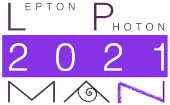Speaker
Description
The LUXE experiment aims at studying high-field QED in electron-laser and photon-laser interactions, with the 16.5 GeV electron beam of the European XFEL and a laser beam with power of up to 350 TW. The experiment will measure the spectra of electrons and photons in non-linear Compton scattering where production rates in excess of 10^9 are expected per 1 Hz bunch crossing. At the same time positrons from pair creation in either the two-step trident process or the Breit-Wheeler process will be measured, where the expected rates range from 10^-3 to 10^3 per bunch crossing, depending on the laser power and focus. These measurements have to be performed in the presence of low-energy high radiation-background. To meet these challenges, for high-rate electron and photon fluxes, the experiment will use Cherenkov radiation detectors, scintillator screens, sapphire sensors as well as lead-glass monitors for backscattering off the beam-dump. A four-layer silicon-pixel tracker and a compact electromagnetic tungsten calorimeter with GaAs sensors will be used to measure the positron spectra. The layout of the experiment and the expected performance under the harsh radiation conditions will be presented.




